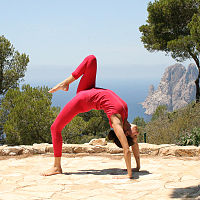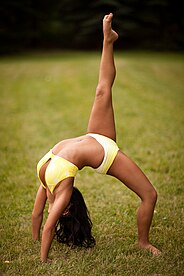Chakrasana

Chakrasana (Sanskrit: चक्रासन, romanized: Cakrāsana, lit. 'Wheel Pose') or Urdhva Dhanurasana (Sanskrit: ऊर्ध्वधनुरासन, romanized: Ūrdhvadhanurāsana, lit. 'Upward-Facing Bow Pose') is a backbending asana in yoga as exercise. The one-legged variant is often chosen by yoga practitioners who wish to advertise themselves.
Etymology and origins

The name Chakrasana comes from the Sanskrit words चक्र chakra, "wheel", and आसन āsana, "posture" or "seat". The name Urdhva Dhanurasana comes from the Sanskrit urdhva ऊर्ध्व, upwards, and dhanura धनु, a bow (for shooting arrows).[1][2][3]
The pose is illustrated in the 19th century Sritattvanidhi as Paryaṇkāsana, Couch Pose.[4]
Description
In the general form of the asana, the practitioner has hands and feet on the floor, and the abdomen arches up toward the sky. It may be entered from a supine position or through a less rigorous supine backbend, such as Setu Bandha Sarvangasana (Bridge Pose). Some advanced practitioners can move into Wheel Pose by "dropping back" from Tadasana (Mountain Pose), or by standing with the back to a wall, reaching arms overhead and walking hands down the wall toward the floor. Advanced practitioners may also follow wheel with any of its variations (listed below), or with other backbends, such as Dwi Pada Viparita Dandasana, or by pushing back up to stand in Tadasana.[5][6]
Preparatory poses are backbends such as Salabhasana (Locust), variants of Bhujangasana (Cobra, Sphinx), and Dhanurasana (Bow).[5]
Counter poses are forward bends including Paschimottanasana (Seated Forward Bend) and Balasana (Child's Pose).[5]
Variations
Many variations of the pose are possible, including:
- Eka Pada Urdhva Dhanurasana (One-Legged Upward Bow or One-Legged Wheel): one leg is lifted straight up into the air.[7][8]
- Camatkarasana (Wild Thing Pose) has one arm lifted and the opposite leg straightened.[9]
-
Camatkarasana, Wild Thing Pose, a modern posture between Vasisthasana and Chakrasana
-
Russian yoga teacher Nina Mel, moving into Eka Pada Urdhva Dhanurasana
Learning the pose

People with tight shoulders or hips may be unable to move into Chakrasana. They can practise the pose using supports such as a pair of yoga bricks placed against a wall under the hands or feet. A mat can be spread over the bricks to prevent slipping.[5] Angled blocks may be more comfortable for the hands, as the slope reduces the strain on the wrists; alternatively, yoga bricks can be propped up on the wall's skirting board or other blocks. In a class, an assistant can stand by the practitioner's head (in place of the wall); the practitioner can then hold the assistant's ankles, and the assistant can hold the practitioner's shoulders.[10]
The pose can be practised against a wall by standing a pace away from the wall, and facing away from it, with the feet about hip width apart. With the knees bent, the arms reach up and then back to the wall, and the head is leant back. If comfortable, the hands may be walked a little further down the wall and the arms and knees straightened.[5]
In culture
On its 40th anniversary, Yoga Journal recalled seven ways it had covered Urdhva Dhanurasana, including a cover of Iyengar Yoga teacher Rama Jyoti Vernon doing the pose in its first year, 1975 and Angela Farmer doing the one-legged variant in 1982.[11] The pose is often chosen by yoga practitioners who wish to advertise themselves: the Welsh author Holly Williams, writing about the commercialisation of yoga in The Independent, commented that she had "unfollowed [several] people on Instagram whose artful shots of their Lycra-clad one-legged wheel poses come with a barrage of hashtags (#fitspo #yogaeverydamnday #beagoddess)."[12]
-
Yoga in advertising: pose by a Lululemon yoga model
See also
- Viparita Dandasana, Inverted Staff pose, has the back similarly arched but the forearms on the ground.
- Bridge (gymnastics)
References
- ^ "Chakrasana". Ashtanga Yoga. Archived from the original on 2011-03-04. Retrieved 2011-04-11.
- ^ Sinha, S. C. (1996). Dictionary of Philosophy. Anmol Publications. p. 18. ISBN 978-81-7041-293-9.
- ^ Kaul, H. Kumar (1993). Yoga and drug addiction. B.R. Publishing Corporation. p. 92. ISBN 978-81-7018-742-4.
- ^ Sjoman 1999, p. 70.
- ^ a b c d e f "Upward Bow (Wheel) Pose". Yoga Journal. 28 August 2007.
- ^ "Urdhva Dhanurasana: The Full Wheel Pose". Gaia. Retrieved 2016-12-04.
- ^ "Eka Pada Chakrasana". Jaisiyaram. Retrieved 21 March 2013.
- ^ "One-Legged Wheel Pose". Yogapedia. 31 March 2018. Retrieved 2 August 2022.
- ^ Anon (31 August 2009). "Wild Thing". Yoga Journal. Retrieved 8 February 2019.
One poetic translation of Camatkarasana means "the ecstatic unfolding of the enraptured heart."
- ^ Lizzie, Jade (17 October 2019). "Chakrasana: How to Perfect Your Wheel Pose". Yogapedia. Retrieved 5 August 2022.
- ^ EichenSeher, Tasha (9 July 2015). "1 Pose, 40 Years: Urdhva Dhanurasana (Wheel Pose)". Yoga Journal.
- ^ Williams, Holly (29 November 2015). "The great hippie hijack: how consumerism devoured the counterculture dream". The Independent. Retrieved 2 August 2022.
Sources
- Iyengar, B. K. S. (1979) [1966]. Light on Yoga: Yoga Dipika. Unwin Paperbacks. ISBN 978-1855381667.
- Sjoman, Norman E. (1999) [1996]. The Yoga Tradition of the Mysore Palace. Abhinav Publications. ISBN 81-7017-389-2.[permanent dead link]






